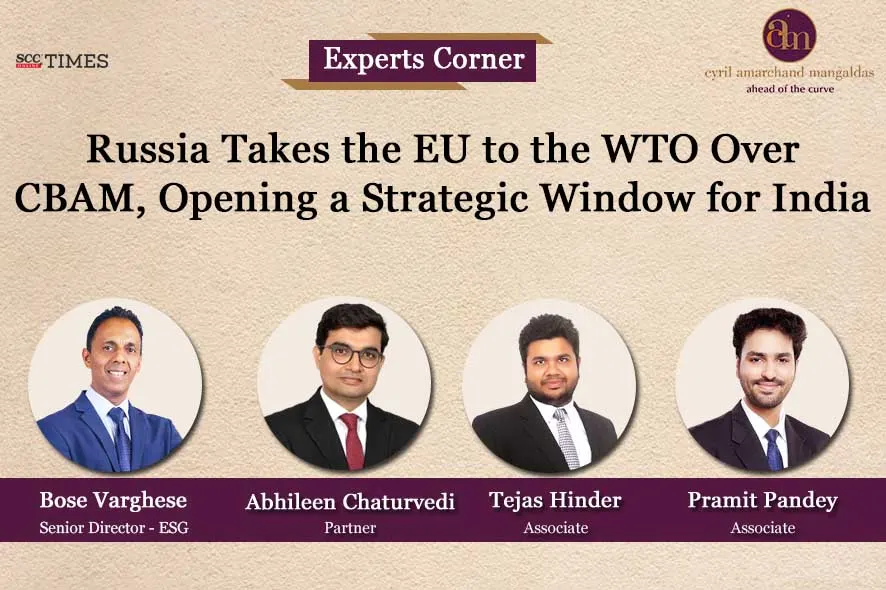Background
On 12-5-2025, the Russian Federation (Russia) submitted a formal request for consultations under Article 4 of the World Trade Organisation (WTO) dispute settlement understanding (DSU)1 with the European Union and its Member States, marking the first legal challenge to the carbon border adjustment mechanism (CBAM) in the WTO. The Russian Government described CBAM and the European Union (EU) Emissions Trading System as “discriminatory”, alleging they serve as tariff-like barriers under the pretext of climate protection. The consultation request explicitly cites inconsistencies with the WTO’s General Agreement on Tariffs and Trade, 19472 (GATT), the agreement on subsidies and countervailing measures and the agreement on import licensing procedures. This action triggers the 60-day cooling-off period; absent resolution, Russia may request the establishment of a formal panel to adjudicate the dispute.
The legal foundations of Russia’s challenge and WTO jurisdiction
Russia’s request for consultations is the first formal WTO dispute over CBAM. At its core, the challenge alleges that the EU’s CBAM violates several WTO agreements.3 Russia has asserted that CBAM is discriminatory, constitutes an unjustifiable restriction on trade and violates the national treatment obligation and the most-favoured nation (MFN) obligations under the WTO agreements. Additionally, it has claimed that the mechanism acts as a de facto tariff inconsistent with the General Agreement on Tariffs and Trade, 1994 which sets binding schedules of tariff concessions.
Importantly, Russia argues that CBAM’s design and application discriminate between EU and non-EU products by imposing carbon pricing obligations only on foreign producers while exempting EU domestic producers that are under the EU Emissions Trading System (ETS) which, according to Russia, amounts to a prohibited subsidy under the WTO agreements. These claims are legally significant as they push the WTO to clarify whether CBAM constitutes a legitimate environmental regulation or disguised protectionism.
CBAM’s architecture is also challenged as a technical regulation under the Technical Barriers to Trade (TBT) Agreement, which requires that such measures not create unnecessary obstacles to international trade. Russia’s principal objection against CBAM is that it is highly trade-restrictive under the pretext of climate policy, arguing that the measure exceeds what is necessary to fulfil its stated environmental objectives and does not provide sufficient flexibility for exporting countries to demonstrate carbon equivalence through their own domestic mitigation efforts.
CBAM and dispute resolution under CBAM
CBAM, codified in EU Regulation 2023/9564, took effect on 17-5-2023, with a transitional phase throughout 2023-2025 and definitive application from 1-1-2026. During the transitional phase, importers are required to report emissions embedded in imports; the definitive phase will make them financially liable to purchase CBAM certificates equivalent to the emissions price they would have faced under the EU ETS. The mechanism is intended to equalise carbon costs between domestic EU products and imports to prevent carbon leakage when the EU firms relocate production to jurisdictions with lax emission constraints. CBAM currently targets cement, steel, aluminium, fertilisers, electricity and hydrogen and requires importers to purchase CBAM certificates to cover the embedded emissions in imported goods. CBAM only targets these sectors for now, and more sectors are likely to follow.
The CBAM contains limited dispute resolution provisions. Challenges to CBAM within the EU system are restricted to administrative and judicial mechanisms available to economic operators. Disputes concerning verification reports, emission declarations or the surrender of CBAM certificates must first be addressed through Customs authorities of the relevant EU Member State. Subsequent challenges may proceed to national courts and ultimately to the Court of Justice of the European Union, primarily on questions of EU law. However, non-EU Governments or exporters, who are arguably the most impacted stakeholders in the implementation of CBAM, cannot directly access these mechanisms unless they have a local subsidiary affected by CBAM.
CBAM dispute resolution under the WTO
According to the EU, the CBAM has been structured to align with WTO principles by tying carbon costs on imports to those imposed on EU domestic producers under the ETS. The EU argues that this ensures parity and preserves the level playing field. However, the measure’s unilateralism, particularly the imposition of EU-defined carbon benchmarks and the limited recognition of non-EU carbon pricing mechanisms, raises questions about whether it respects the principle of “common but differentiated responsibilities” under international climate law, and whether it is justifiable under Article 20 of the GATT, which allows exceptions for environmental protection. Furthermore, developing nations argue that CBAM, through its reliance on EU-set default values and heavy administrative requirements, imposes significant costs and regulatory uncertainty. Such burdens disproportionately affect exporters from emerging economies lacking robust emissions-monitoring infrastructure. The requirement to verify and surrender certificates intensifies transaction complexity and may act as an informal trade barrier.
WTO dispute resolution process and challenges
The resolution process starts with a request for consultation under the DSU, as Russia initiated in May 2025. If unsuccessful, Russia may then request the formation of a panel, which will examine whether CBAM violates any of the WTO agreements. Once constituted, the panel in the Russia — EU CBAM dispute will issue a report that places CBAM’s legality squarely under international diaspora. The findings of this panel will carry significant legal weight, as they must be adopted by the WTO’s DSU unless there is a unanimous negative consensus or such panel findings can be appealed to the appellate body.
Even if the matter proceeds through consultations, upon failure of which panel findings are issued, there remains a risk that any appeal basis such panel findings could be made “into the void”, as the appellate body of the WTO has been dysfunctional since December 2019, leaving enforcement in limbo and deepening the WTO’s crisis of dispute resolution. Despite the appellate body’s paralysis, the world will witness a legal and political test of CBAM’s compatibility with WTO rules through the dispute settlement process itself. Hence, the forthcoming panel findings will mark a crucial moment in testing the WTO-consistency of CBAM, and despite the appellate vacuum, it will serve as a benchmark for future climate-trade measures globally.
The larger issue, however, is systemic i.e. whether WTO’s dispute settlement mechanisms are capable of reconciling climate objectives with trade obligations. WTO agreements permit exceptions for measures necessary to protect human, animal or plant life and those related to the conservation of exhaustible natural resources. Yet, these exceptions are narrowly construed and require that the measure not be “arbitrary or unjustifiably discriminatory”, a test that CBAM may fail due to its unilateral benchmarks and limited recognition of foreign mitigation efforts.
India’s strategic calculus: Exposure, preparedness and legal posture
India is not a complainant or respondent in the Russia-EU dispute, but the legal issues at stake are profoundly relevant to its economic and trade interests. Sectors such as aluminium and iron & steel are directly exposed. Additionally, Indian corporations with operations or joint ventures in Europe could face fragmented regulatory burdens. A significant portion of India’s iron and steel exports were destined for the EU in 2022; CBAM could impose a concerningly high tax on these exports, potentially undermining the competitiveness of Indian industries when CBAM moves into its compliance period in 2026.
India has consistently raised CBAM concerns at WTO forums, notably in the Committee on Trade and Environment, alongside countries like Colombia.5 If Russia’s challenge advances to panel proceedings, India could join as a third party to the dispute to preserve its procedural and legal interests, particularly to assess the validity of CBAM benchmarks vis-à-vis WTO agreements.
Countries such as the United States of America or the United Kingdom are set to introduce domestic carbon pricing or emissions trading frameworks. The United Kingdom is set to introduce a domestic CBAM starting 1-1-2027. Whereas the United States, through the US Foreign Pollution Fee Act, 20236 — draft is going to introduce measures akin to CBAM in the not-so-distant future. The extraterritorial effects of such environmental regulations are likely going to impact global trade as well as long-term manufacturing arrangements. The risk is particularly acute for developing countries that lack comparable carbon pricing tools or institutional capacity to respond effectively to such measures.
Finally, the dispute has implications for India’s role in shaping WTO jurisprudence. India has been a strong voice for policy space and developmental equity within the WTO. This dispute could enable it to articulate legal arguments against climate unilateralism while proposing institutional innovations, such as a green transition fund or differentiated implementation timelines, for trade-environment balance.
Conclusion
It is pertinent to note that CBAM is limited in its deterrent approach. It does not prohibit the import of goods produced through carbon-intensive processes, but merely penalises them, allowing such environmentally harmful production to persist globally. At the same time, by imposing financial costs on these products, CBAM adopts a deterrent approach aimed at nudging manufacturers toward greener production alternatives. This creates a fundamental dichotomy.
Russia’s challenge brings the first real opportunity for a WTO Panel to adjudicate on the legality of carbon pricing at borders. It brings to the fore complex intersections between trade obligations, environmental policy and the sovereign right of States to regulate in pursuit of climate goals. At the heart of this confrontation lies the unresolved question of whether and how unilateral climate measures, like CBAM, can be reconciled with multilateral trade rules rooted in non-discrimination, transparency and market access. Hence, as indicated previously, if a panel is established and proceeds to adjudicate, the ruling will likely have an impact on all future climate-trade measures globally.
For India, the implications are direct and immediate. With a growing export portfolio in CBAM-targeted sectors and no formal carbon pricing regime of its own, Indian industries face rising compliance costs and competitiveness pressures. Simultaneously, the dispute signals a broader systemic shift toward climate-trade conditionality, where market access is increasingly conditioned on environmental performance. This has serious implications not only for India’s trade policy but also for its carbon transition pathways, investment priorities, and climate diplomacy. India must therefore view the Russia-EU CBAM litigation as a strategic opportunity.
*Senior Director — ESG, Cyril Amarchand Mangaldas.
**Partner, Cyril Amarchand Mangaldas.
***Associate, Cyril Amarchand Mangaldas.
****Associate, Cyril Amarchand Mangaldas.
1. Agreement Establishing the World Trade Organisation, 1994, Art. 4.
2. General Agreement on Tariffs and Trade, 1947.
3. General Agreement on Tariffs and Trade, 1994, Agreement on Technical Barriers to Trade, 1995, Agreement on Subsidies and Countervailing Measures, 1995 and Agreement on Import Licensing Procedures, 1995.
4. Regulation (EU) 2023/956 of the European Parliament and of the Council.
5. European Union — Deforestation Free Commodities, available at <https://tradeconcerns.wto.org/en/stcs/details?imsId=203&domainId=CTG&searchTerm=deforestation>.
6. Foreign Pollution Fee Act, 2023 (US).



